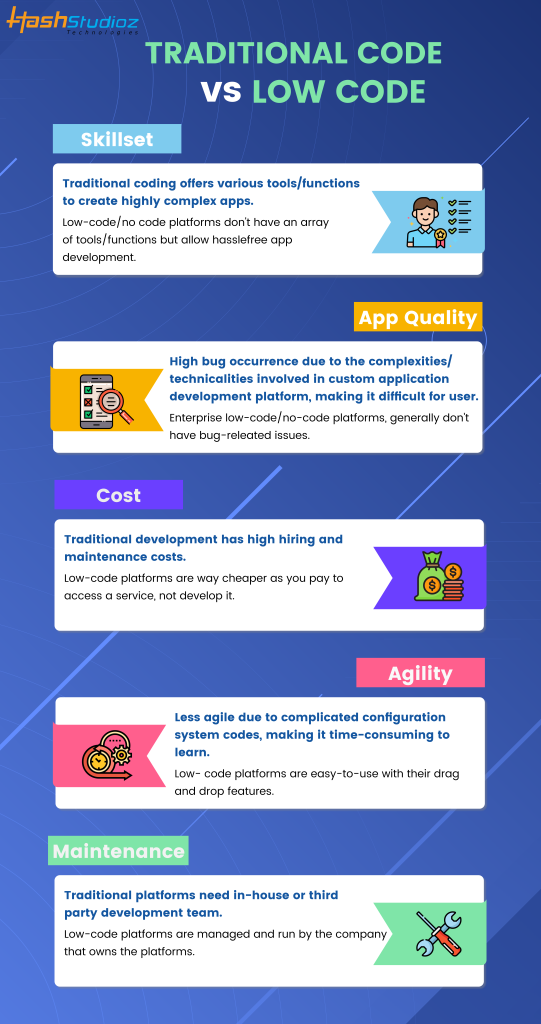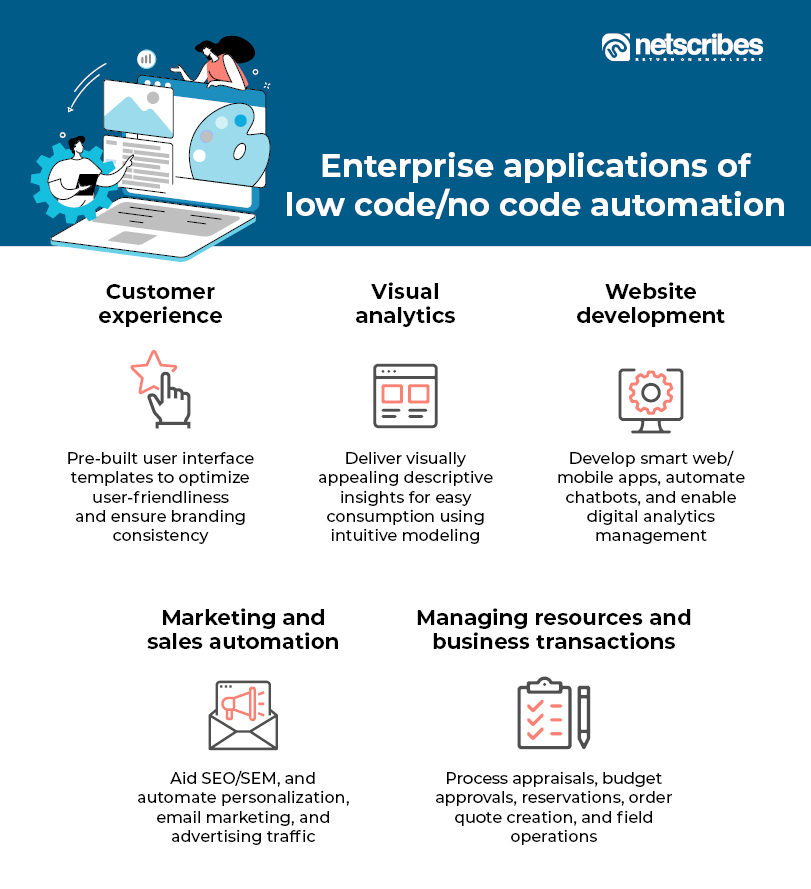New Suggestions For Choosing Low-Code Platform Sites
New Suggestions For Choosing Low-Code Platform Sites
Blog Article
Benefits Of Low-Code Development In Terms Of Speed
Visual Development Environment :
Drag-and-Drop Interfaces: Low-code platforms provide visual tools for designing applications. Developers can build an application using drag-and-drop elements without having to write code.
Templates and components that have been pre-built A lot of platforms that support low-code come with templates and components that are pre-built, allowing developers to prototype quickly and build applications without needing to start entirely from beginning from scratch.
Reduced Coding Needs:
Automated Code Generating: Low-code platform generates the code underneath based upon the visual models that developers design. This helps reduce the need for manual code coding and improves the speed of development.
Reusable component: Developers are able to make use of the same components in various projects. This reduces the time spent testing and writing code.
Collaboration Streamlined:
Low-code development platforms are often equipped with tools like deployment, version control, and testing. This allows seamless collaboration between teams.
Citizen Development (Citizen Development) User and non-developers of business applications can take part in application development using intuitive interfaces. This can help reduce the bottleneck created by limited professional developer availability.
Rapid prototyping and rapid iteration
Rapid prototyping: Developers are able to quickly build prototypes that can be used to test ideas and collect feedback, resulting in quicker iterations.
Easy Modifications: Low-code development is visually oriented, making it easier to change and update applications. It also speeds up the process for developing and improving applications in response to user feedback.
Pre-built Integrations:
API Integrations Low-code platforms include already built connectors that can be used with APIs or services that are popular. They can speed up the process it takes to integrate external applications.
Data Integration: Built-in tools for data-integration make it easier to connect databases and data sources. This accelerates development.
Deployment Scaling
One-Click Deployment: A lot of low-code platforms have one-click deployment, greatly decreasing the amount of time and effort needed to deploy software.
Cloud-based solutions: Cloud low-code platforms are capable of handling the management of infrastructure and scaling. Developers are able to concentrate on the functions and application logic rather than deployment logistic.
Low-code development of applications is a more efficient method to create apps. It streamlines and automates various elements of the procedure. This makes it easier to speed up development and the ability to adapt to evolving requirements. Check out the top Low-code Platform for application development blog for blog examples including mobile app development platforms, develop web app, application modernization, push alerts, rapid application design, sso azure, cross platform mobile app development, rad application development, push alerts, cloud software applications and more.
Benefits Of Low-Code Application Development For Governance And Security
Low-code development can bring many advantages in terms of security and governance. These are important for ensuring applications are safe, secure and properly managed throughout their lifecycle. These are the main benefits.
Unified management console: Low-code platforms typically provide a centralized administration console from which administrators can manage all applications and maintain a consistent governance within the organization.
Role-Based Access Control RBAC: These platforms have robust controls based on role that allow administrators to establish access policies. This allows only authorized users to alter or access specific parts of a program.
Compliance and Regulatory Applicability:
A majority of low-code platforms include conformity features. They are built to conform to industry standards and regulations such as GDPR or HIPAA. They provide tools and frameworks to help ensure that applications comply with these standards.
Audit Trails and Logging Audit trails and logs that are comprehensive can be integrated to enable organizations to track changes in access, and monitor access and the compliance.
Enhance Security Measures
Data Encryption. Low-code platforms usually provide encrypted data built-in when in transit as well as when at rest. This helps protect sensitive information.
Security Certifications: A lot of low-code providers have security certifications (e.g., ISO 27001, SOC 2) that show that they adhere to the highest security standards, providing additional assurance to users.
Automated Security Updates
Regular Patching and Updating Lowcode platforms typically provide regular security updates. These patches protect software from the latest threats without the need for developer intervention.
Security Monitoring: Continuous security monitoring tools are used to send real-time notifications as well as information about potential security issues.
Data Governance
Data Access Policies These platforms permit organizations to define data access policies and then enforce them, ensuring data is available only to those who have been granted access. They also ensure the data is used correctly.
Data Masking and Anonymization: Built-in tools to mask and anonymize data safeguard sensitive data, particularly in development environments and testing environments.
Consistent Lifecycle Management of Applications
Development and deployment pipelines Lowcode platforms usually provide integrated pipelines for development and deployment that include security checks. They provide protection throughout the lifecycle of the application.
Version Control: Integrated version control allows for the management of changes and ensures that any changes to the application can be monitored and reversed if needed while ensuring the integrity of the application.
User Authentication, Authorization and Authorization
Single Sign-On - Support for single sign-on (SSO) as well as other advanced methods of authentication simplify management and enhances security.
Multi-Factor Authentication (MFA) Numerous platforms offer built-in support for multi-factor authentication. It adds an extra layer of security for accessing applications.
Policy enforcement and Compliance Monitoring:
Policy Templates: Low-code platforms usually have pre-defined templates for security and governance which allow companies to swiftly adopt policies.
Tools for Monitoring Compliance: These tools track and report continuously on compliance status. They make it easier to identify problems and address these issues in a proactive fashion.
Integration into Existing Security Infrastructure:
Seamless Intergration: Low code platforms are designed to allow seamless integration with existing security tools and equipment, like Identity Management Systems SIEM Solutions (Security Information and Event Management), and Firewalls.
API Security API Security Features: Built-in API security functions ensure that integrations with other systems are secure, protecting data and maintaining application integrity.
Training and Best Practices:
Guided Best Practices : A lot of platforms provide guidelines and best practices to help non-developers adhere with security standards.
Some lowcode providers provide tools and security education for users to understand how to build and maintain a secure application.
In general, low-code developers have a security and governance benefit which allows them to create and manage their applications in a controlled, regulated and secure manner. These platforms offer the tools and frameworks necessary to protect sensitive data as well as enforce policies and keep regulatory compliance in place, all while facilitating the management and oversight of the application development process. Take a look at the recommended more helpful hints for site recommendations including app dev platform, application modernization software, cloud software applications, sso azure, rad application development, mobile app development platforms, driver jdbc, develop cross platform mobile app, application modernisation, rapid app development and more.
Benefits Of Low-Code App Development In Terms Limitations And Customization
Low-code development is an integrated approach that offers important advantages in terms of dealing with limitations and permitting customisation. Here are some benefits:
In overcoming Complexity Barriers:
Low-code development platforms are easy to use because they provide pre-built components, templates, and other tools. They also facilitate rapid deployment of even the most complex applications.
Many platforms have wizards and workflows that are guided to aid developers in understanding complex processes. These tools reduce the chance of making mistakes, and help ensure uniformity.
Scalability Solutions
Scalability is built into low-code platforms. They are often equipped with features that allow for an scalable architecture. This enables applications to handle higher loads without requiring major redevelopment.
Performance Monitoring: Tools for monitoring and optimizing performance are integrated into the application to make sure it's efficient even as it scales.
Security and Compliance
Integrated security features: Low-code platforms have security measures like encryption, role-based control of access, and automated compliance checking that address security issues.
Platforms are regularly updating their security protocols as well as measures of compliance, which ensures that applications remain safe against new threats.
Customization Capabilities:
Extensibility:
Custom Code Integration : Low-code platforms often allow the integration of custom codes (e.g. JavaScript, Python) which enables developers to extend the functionalities beyond what is available in the standard features.
Custom Plugins and Modules: Developers can create custom plugins or modules to include specific functions that are tailored to the specific requirements of a particular business.
APIs and integration
API Support - Complete support of APIs allows seamless integration with external systems and services and allows for complete modification.
Third-Party Services: Low-code platform typically provides pre-built connections to popular services provided by third-party providers which makes integration and customization easy.
Flexible UI/UX Design
Customizable Interfaces Developers are able to design and customize user interfaces in line with specific usability and branding criteria, resulting in a customized user experience.
Responsive Designs: The software can be tailored to fit various screen sizes and devices.
Business Logic Customization
Visual Workflow Builders Visual tools for designing and customizing workflows as well as business logic allow developers to develop complex, customized processes without extensive coding.
Platforms can provide conditional logic to accommodate certain business rules or situations.
Data Management:
Custom Data models: Developers have the ability to create custom data models to meet specific application requirements, and ensure that data handling meets the requirements of business.
Advanced Data Processing Integration and advanced data handling tools allow for customisation of data analysis and use within the application.
Balance Customization and Limitations
Frameworks and Standards
Low-code platforms are compliant with the industry standard and best practices. This helps maintain the highest quality and security of applications.
Governance Frameworks. Built-in frameworks of governance make sure that any modifications do not affect the security, compliance or integrity of the application.
Iterative Development:
Rapid prototyping: The capability to quickly prototype and test customizations ensures that developers can iterate based on user feedback and refine the application to meet the needs of users.
Low-code platforms enable continuous improvement by allowing continuous customization and further enhancing as business requirements develop.
User Empowerment
Empowering Citizen developers: Low-code interfaces that are intuitive allow non-developers to make customizations. This boosts the number of contributors able to modify and improve applications.
Training and Support A lot of platforms provide extensive training and support resources to assist users with effective customizations without compromising the stability of the application or its performance.
In the end, low-code application development provides a framework that is strong and adaptable enough to handle limitations while still allowing for plenty of customisation. This allows companies to create and maintain applications that are both functional and tailored to specific business needs. All while maintaining security, quality as well as scalability and standards.